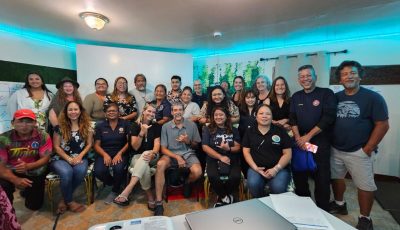#WeWalkCNMI this month
One in 10 Americans has diabetes. That translates to more the 30 million people.
Another 84 million adults in the United States are at risk of developing Type 2 diabetes.
Diabetes is one of the leading causes of disability and death in the United States.
These sobering facts are the reasons for the designation of November as Diabetes Prevention Month,
which is observed across the United States and its territories.
In line with this, the Diabetes Prevention and Control Program of the Commonwealth Healthcare Corp.
will be raising awareness about diabetes and help promote the non-communicable disease’s prevention.
Based on the 2016 Non-Communicable Diseases and Risk Factor Hybrid Survey Report, the prevalence of diabetes in the CNMI ranges from 12.5 to 18 percent.
CHCC physician Dr. Beth Kohnen said that people need to think whether they are at risk for diabetes.
“Look at your immediate environment—your family. Do you have a first-degree relative like your mother, father, sister, brother, or child with diabetes?” she asked. Someone like that has five to 10 times higher lifetime risk of developing diabetes than someone who does not, she added.
“Other tests include checking your national descent. Are you a Pacific Islander, Hispanic, or of African or Asian descent? Are you overweight? Is your lifestyle sedentary and you don’t get exercise? Do you eat a diet with lots of sugar coming from sweetened beverages, sweet treats or simple sugars like white rice, bread, few vegetables and white grains? Lifestyle and diet are big factors in contributing to being at risk for Type 2 diabetes,” she added.
If one has diabetes, the best way to manage the disease is to keep the blood sugar as close to normal as possible.
“[A blood sugar of] 70 to 110 is normal most of the time for people who don’t have diabetes, so if you are diabetic, the goal is to keep blood sugar as close to those numbers. You can test blood sugar at home by using a handheld machine called glucometer. Another way is having your hemoglobin A1C or ‘glycohemogloblin’ tested by your health care provider or make an appointment at the Family Care Clinic at CHCC.”
According to Kohnen, for people who don’t have symptoms but are at risk of developing diabetes, weight maintenance and staying active are good preventive measures.
“Keep an appropriate weight. Your body mass index should be under 25. To determine your BMI, take your weight in kilograms and divide it by your height in meters squared. Also, there are many BMI calculators available online.”
“Staying active doesn’t only prevent diabetes but helps promote the overall wellbeing of a person,” she added.
Making people adopt an active lifestyle is a challenge in the community as 33 percent of CNMI adults reported not having participated in any physical activity or exercise in the past month, according to the 2016 Non-Communicable Diseases and Risk Factor Hybrid Survey Report. Lack of exercise has been linked to chronic diseases, including diabetes.
As the campaign against diabetes pushes this month, the Diabetes Prevention and Control Program, in collaboration with the Commonwealth Diabetes Coalition, will be launching a walking initiative called #WeWalkCNMI.
CHCC CEO Esther Muña said the goal of #WeWalkCNMI is to encourage the community to walk for better health.
The #WeWalkCNMI will happen from 5:30pm to 6:30pm on Nov. 14 at the Laolao Bay Golf & Resort pathway, Nov.16 at Tanapag Middle School, Nov. 21 at Garapan Public Market and at Coral Ocean Point, Nov. 28 at
Dandan Baseball Field, Nov. 30 at the Oleai and Kilili pavilions.
“We hope that through promoting simple activity, more people will be motivated to adopt a healthier lifestyle,” Muña said.



























